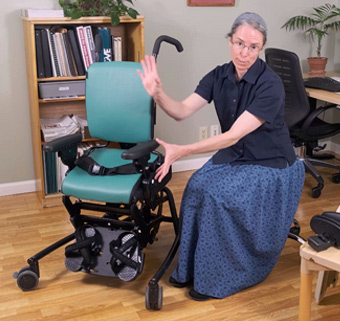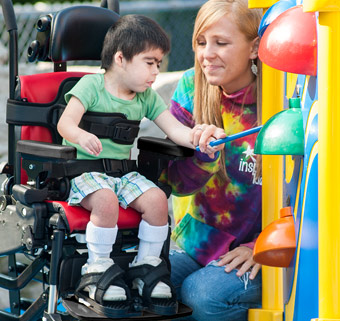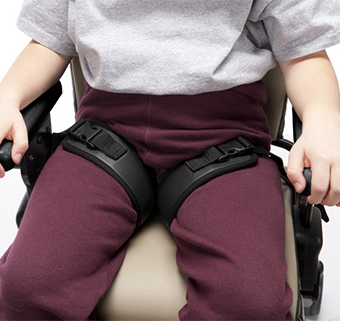Adaptive Seating: The Right Choice
| July 2011An ICF-based Approach
Contributed by Petros Stamatiadis, PT
Adaptive seating is essential for children with neurological or neuromuscular disorders such as cerebral palsy, muscular dystrophy, and meningomyelocele . Because they are prone to developing scoliosis and other musculoskeletal deformities, children with severe motor disorders need special needs seating equipment to help with positioning and alignment of the trunk.
Children with mild or moderate conditions can also benefit from the use of a special needs chair. By providing good alignment, the special needs chair promotes hand functionality 1, activation of the postural (back) muscles, vocalization 2, and pulmonary function 3, giving the possibility of continuing therapeutic intervention at home.
The choice of the special needs chair is usually based on the criterion of good support for the child. However, there are other parameters to consider, as discussed below.
Many special needs chairs, with the essential adjustments, are placed on a Hi-Low base. These chairs have some advantages including:
- The height is adjustable and facilitates the caregiver for the handling during feeding and play time.
- The kids are at the same height as their peers and can communicate with them face to face.
- The seat height is adjustable in regard to the table or the desk.
But regardless of these advantages there is still the question. Is the Hi-Low base suitable in all cases for all children? I think the answer is no.
Using the ICF Gross Motor Function Classification for Selecting Adaptive Equipment
According to the International Classification of Functioning, Disability and Health (ICF), environmental factors play a vital role in intervention, for increasing the functionality and participation of the disabled 4. Thus the proper choice of adaptive equipment will not only improve body functions but will also act as a facilitator to increase functionality and participation. On the other hand, the wrong choice of adaptive equipment may act as a barrier in some cases, depending on the goal of the rehabilitation.
For children who can transfer independently and walk with or without a handheld mobility device (levels II and III of the Gross Motor Function Classification System – GMFCS) and for children who can support weight with their legs to assist with standing transfers or walk with a body support walker (level IV of the GMFCS)5, the better choice is a special needs chair that promotes the activation of postural muscles, that increases hand functionality and pulmonary function, and also facilitates the user to stand up with minimal or no help from the caregiver.
Standard Base Rifton Activity Chair
A Hi/Lo base chair can act as a barrier for the more active children because it prohibits the user to stand up to walk or to transfer from one point to another without help from the parents. This happens because the caregiver has to lower the chair, take off the footboard and help the child to come to the standing position. Moreover, when the footboard is off, the feet cannot touch the ground because the Hi-Low chairs usually are high, even when in their lowest position.
The Standard Base Rifton Activity Chair covers the needs of a large group of children with disabilities, providing a more dynamic approach for therapeutic intervention. It provides good support, alignment of the trunk and avoidance of posterior pelvic tilt. The adjustment of forward tilt promotes the activation of the postural muscles of the back, as well as hand functionality, pulmonary function and vocalization. The forward leaning position also gives the potential to train the user to come to the standing position to walk with a device.
For children with mild to moderate involvement (levels II, III and sometimes IV of Gross Motor Function Classification System) this kind of special needs chair can not only increase capability (what the child can do in the controlled environment during therapy) but also increases performance (what the child does do in everyday settings), and thus gives to the child the ability to participate more actively in daily activities without restricting him/her.
Hi/Lo Base Rifton Activity Chair
On the other hand the primary goal for the more severely involved children (level V and sometimes level IV of the Gross Motor Function Classification System) is good support and avoidance of musculoskeletal deformities. For these children the Hi/Lo base seating system may be a more suitable choice because it provides good support and gives the user the ability to be on the same height with his/her peers and communicate with them face to face. It also gives the advantage of adjusting the height to the proper level during feeding or playtime, to help the child participate more easily in activities during family leisure time.
REFERENCES
- Stavness C. (2006). The effect of positioning for children with cerebral palsy on upper–extremity function: a review of the evidence. Phys Occup Ther Pediatr, 26(23), 39-53
- Hulme J., Bain B., Hardin M., McKinnon A., Waldron D. (1989).The influence of adaptive seating devices on vocalization. J Commun Disord., 22(2), 137-145
- Nwaobi, O.M., Smith P.D. (1986). Effect of adaptive seating on pulmonary function of children with cerebral palsy. Developmental Medicine and Child Neurology, 28 (3), 351-354.
- World Health Organization (2001). International Classification of Functioning, Disability and Health: ICF. Geneva, Switzerland
- Palisano R., Rosenbaum P., Walter S., Russell D., Wood E., Galuppi B. (1997). Development and reliability of a system to classify gross motor function in children with cerebral palsy. Developmental Medicine & Child Neurology , 39, 214-223
Petros Stamatiadis is a pediatric physical therapist trained in Neurodevelopmental Treatment with more than 12 years of experience working with children. He was member of the study group for the pilot study for the reliability and feasibility of the Greek version of the ICF. He is co–partner of ProMed and can be reached at pstamatiadis@promed.gr




